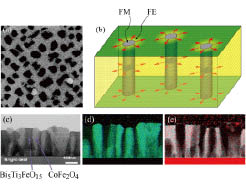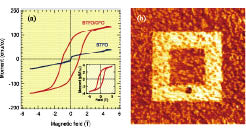Multiferroic Nanopillar Composites
Y. Matsumoto and M. Lippmaa
Composite materials can be used to elastically couple ferroelectrics and ferromagnets, producing a multiferroic material where the magnetization can be controlled by an electric field or the dielectric polarization by a magnetic field. In this work, a nanoscale pillar-and-matrix composite, consisting of a layered Bi5Ti3FeO15 (BTFO) perovskite matrix and nanoscale pillars of a ferrimagnetic spinel CoFe2O4 (CFO), were used to study the effectiveness of nanoscale strain-mediated elastic coupling. The main advantage of this approach is that it may be possible to develop new types of multiferroics that can work close to room temperature and do not contain lead.

Fig. 1. (a) Scanning electron microscope image of the nanocomposite film surface and (b) a three-dimensional model of the composite material. The elastic strain field surrounding the nanopillars is marked with red arrows. (c) Cross-sectional electron microscope image and (d) Co/Fe and (e) Bi/Ti EDS mapping images.

Fig. 2. (a) Magnetization comparison of a pure BTFO matrix and the BTFO/CFO nanocomposite film, showing the presence of ferromagnetism in the nanopillars. Inset shows the magnetization of a pure CFO sample. (b) A ferroelectrically poled pattern on the surface of a nanocomposite film, measured with a piezoresponse force microscope.
A three-dimensional model of the composite material is shown in Fig. 1(b), together with a surface electron microscope image in Fig. 1(a). The pillars form spontaneously during thin film growth due to immiscibility of the perovskite and spinel phases and extend throughout the thickness of the thin film, as shown in the cross-sectional transmission electron microscope image in Fig. 1c. Composition mapping shows nearly perfect segregation of Fe/Co and Bi/Ti in pillars with an average diameter of about 50 nm.
From the point of view of achieving elastic multiferroic coupling in a nanoscale composite, strain fields along the walls of the nanopillars are critically important. The behavior was analyzed by high-resolution electron microscopy, which showed that the nanostructure-matrix interface is heavily strained. The strain relaxes gradually in the BTFO matrix, as illustrated by the red radial arrows in Fig. 1(b). Ferroelectric switching in the BTFO matrix material was studied by piezoresponse force microscopy, showing that the polarization response depends on the volume fraction of nanopillars, reaching a maximum for a CFO volume of 35%. A bipolar poling pattern for this sample is shown in Fig. 2(b). Analysis showed the presence of both in-plane (ab plane) and out-of-plane (c-axis) polarization components, which is unusual for layered bismuth perovskite ferroelectrics where the polarization direction is in the ab plane. Thermodynamic Landau-Ginzburg-Devonshire (LGD) calculations showed that this is a direct result of the strain fields surrounding the nanopillars and may also be caused by the presence of shear domains at pillar boundaries that are not perfectly c-axis oriented. Magnetization analysis of the composites at 10 K showed that the saturation magnetization of CFO is not significantly affected by the 50 nm diameter of the nanopillars (Fig. 2a), reaching nearly the expected 4 µB/f.u. of bulk CFO.
The work showed that systematic strain control is possible in spontaneously-formed nanopillar composites consisting of a spinel ferromagnet and a perovskite ferroelectric. The piezoresponse analysis showed that the three-dimensional nanoscale structuring and the associated strain fields are critical for obtaining suitable polarization behavior in the layered bismuth ferroelectrics. Work is now underway to determine the multiferroic response in such nanocomposite systems.
References
- [1] A. Imai, X. Cheng, H. L. Xin, E. A. Eliseev, A. N. Morozovska, S. V. Kalinin, R. Takahashi, M. Lippmaa, Y. Matsumoto, and V. Nagarajan, ACS Nano 7, 11079 (2013).
